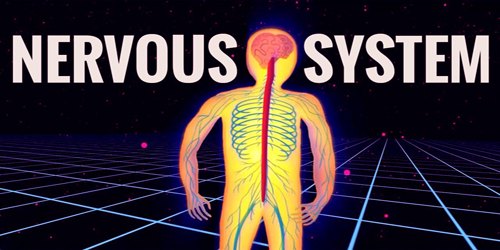The nervous system is the body part of an animal that coordinates its behavior and transmits signals between different regions of the body. The nervous system detects environmental changes affecting the body, then works in tandem with the endocrine system to respond to such events. Nervous tissue was first grown in worms about 550 to 600 million years ago. Invertebrates it consists of two main parts, called the central nervous system (CNS) and the peripheral nervous system (PNS). The CNS contains the brain and spinal cord. The PNS basically consists of nerves, which are closed bundles of long fibers or axons that connect the CNS to every part of the body. All living things are able to detect changes in themselves and in their environment. Changes in the external environment include light, temperature, sound, speed, and smell, but changes in the internal environment include the head and limbs as well as internal organs. Both the autonomic and enteric nervous systems work voluntarily. The nerves that come out of the function cranium are called cranial nerves and the nerves that come out of the spinal cord are called the spinal nerves.
At the cellular level, the nervous system is defined by the presence of a special type of cell, called a neuron, also known as a “nerve cell.” Neurons have special properties that allow them to transmit signals quickly and precisely to other cells. There are two common types of nervous systems, diffuse and centralized. In the diffuse type system found in the lowest invasive region, there is no brain, and the neurons are distributed throughout the organism in a net-like pattern. The higher variant and a part of the nervous system in the central system of the spinal cord play an influential role in coordinating information and managing responses. A cell that receives synaptic signals from neurons may be excited, inhibited, or otherwise transformed. Connections between neurons can form neural paths, neural circuits, and larger networks that create an organism’s perception of the world and determine its behavior. In addition to neurons, the nervous system also contains other specialized cells called glial cells (or simply glia) that provide structural and metabolic support. Recent evidence suggests that glial may also play a significant signal role.
The human nervous system contains about 10 billion nerve cells. The only multilingual animals that do not have the slightest damage to the nervous system are the sponges, placozoans and mesosoans, whose body plans are very simple. The nervous systems of radially symmetric organisms ctenophores (blanket jelly) and synergians (including anemones, hydrangeas, corals, and jellyfish) consist of a diffuse nerve mesh. It is expressed through the neuronal activity in different parts of the body depending on the individual and does not depend on any apparently dominant cell. At the other end of the spectrum, the stimulus may be indirect, such as the sound of rocks being cut in a calm forest, indicating that an animal is slipping. This can lead to a cascade of reactions. The size of the nervous system The sequence of 300 billion cells in humans starts from a few hundred cells of the simplest worms.
The central nervous system works to transmit signals from one cell to another or to transmit and respond from one part of the body to another. Physical damage due to genetic defects, trauma or toxicity, infection, or damage to the nervous system due to aging can occur. It supplies nerves to cardiac and smooth muscle tissues (“innate”). The autonomic nervous system is made up of two elements, which act as opposites to each other: the sympathetic nervous system, responsible for the body’s “fight-or-plane” danger response, and the parasympathetic nervous system, which calms the body. The most common problem in the peripheral nervous system is nerve conduction failure that can be caused by a variety of factors, including diabetic neuropathy and dimming diseases such as multiple sclerosis and amyotrophic lateral sclerosis. Neuroscience is a field of science that focuses on the study of the nervous system.














